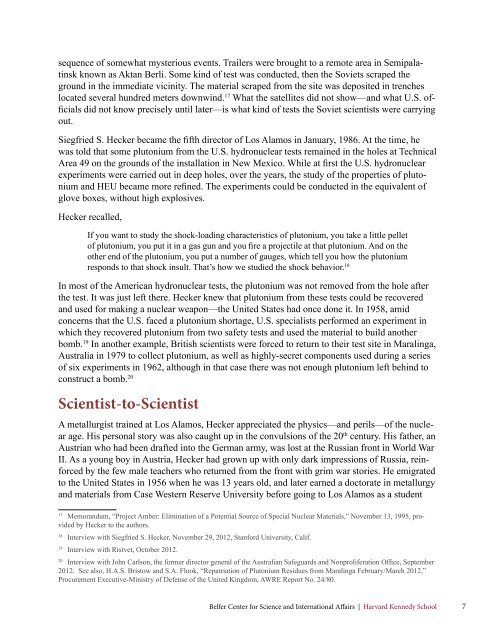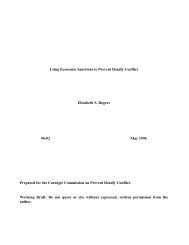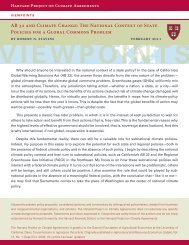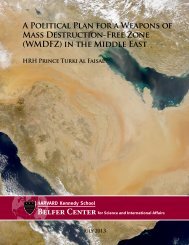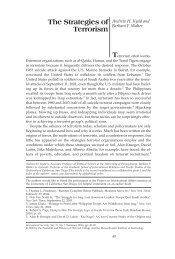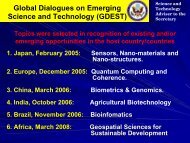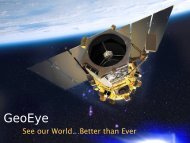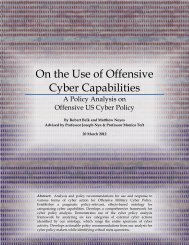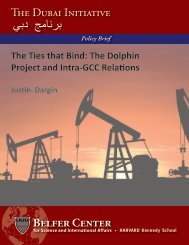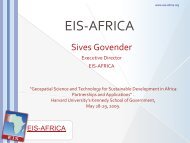Plutonium Mountain - Belfer Center for Science and International ...
Plutonium Mountain - Belfer Center for Science and International ...
Plutonium Mountain - Belfer Center for Science and International ...
- No tags were found...
Create successful ePaper yourself
Turn your PDF publications into a flip-book with our unique Google optimized e-Paper software.
sequence of somewhat mysterious events. Trailers were brought to a remote area in Semipalatinsk<br />
known as Aktan Berli. Some kind of test was conducted, then the Soviets scraped the<br />
ground in the immediate vicinity. The material scraped from the site was deposited in trenches<br />
located several hundred meters downwind. 17 What the satellites did not show—<strong>and</strong> what U.S. officials<br />
did not know precisely until later—is what kind of tests the Soviet scientists were carrying<br />
out.<br />
Siegfried S. Hecker became the fifth director of Los Alamos in January, 1986. At the time, he<br />
was told that some plutonium from the U.S. hydronuclear tests remained in the holes at Technical<br />
Area 49 on the grounds of the installation in New Mexico. While at first the U.S. hydronuclear<br />
experiments were carried out in deep holes, over the years, the study of the properties of plutonium<br />
<strong>and</strong> HEU became more refined. The experiments could be conducted in the equivalent of<br />
glove boxes, without high explosives.<br />
Hecker recalled,<br />
If you want to study the shock-loading characteristics of plutonium, you take a little pellet<br />
of plutonium, you put it in a gas gun <strong>and</strong> you fire a projectile at that plutonium. And on the<br />
other end of the plutonium, you put a number of gauges, which tell you how the plutonium<br />
responds to that shock insult. That’s how we studied the shock behavior. 18<br />
In most of the American hydronuclear tests, the plutonium was not removed from the hole after<br />
the test. It was just left there. Hecker knew that plutonium from these tests could be recovered<br />
<strong>and</strong> used <strong>for</strong> making a nuclear weapon—the United States had once done it. In 1958, amid<br />
concerns that the U.S. faced a plutonium shortage, U.S. specialists per<strong>for</strong>med an experiment in<br />
which they recovered plutonium from two safety tests <strong>and</strong> used the material to build another<br />
bomb. 19 In another example, British scientists were <strong>for</strong>ced to return to their test site in Maralinga,<br />
Australia in 1979 to collect plutonium, as well as highly-secret components used during a series<br />
of six experiments in 1962, although in that case there was not enough plutonium left behind to<br />
construct a bomb. 20<br />
Scientist-to-Scientist<br />
A metallurgist trained at Los Alamos, Hecker appreciated the physics—<strong>and</strong> perils—of the nuclear<br />
age. His personal story was also caught up in the convulsions of the 20 th century. His father, an<br />
Austrian who had been drafted into the German army, was lost at the Russian front in World War<br />
II. As a young boy in Austria, Hecker had grown up with only dark impressions of Russia, rein<strong>for</strong>ced<br />
by the few male teachers who returned from the front with grim war stories. He emigrated<br />
to the United States in 1956 when he was 13 years old, <strong>and</strong> later earned a doctorate in metallurgy<br />
<strong>and</strong> materials from Case Western Reserve University be<strong>for</strong>e going to Los Alamos as a student<br />
17<br />
Memor<strong>and</strong>um, “Project Amber: Elimination of a Potential Source of Special Nuclear Materials,” November 13, 1995, provided<br />
by Hecker to the authors.<br />
18<br />
Interview with Siegfried S. Hecker, November 29, 2012, Stan<strong>for</strong>d University, Calif.<br />
19<br />
Interview with Ristvet, October 2012.<br />
20<br />
Interview with John Carlson, the <strong>for</strong>mer director general of the Australian Safeguards <strong>and</strong> Nonproliferation Office, September<br />
2012. See also, H.A.S. Bristow <strong>and</strong> S.A. Flook, “Repatriation of <strong>Plutonium</strong> Residues from Maralinga February/March 2012,”<br />
Procurement Executive-Ministry of Defense of the United Kingdom, AWRE Report No. 24/80.<br />
<strong>Belfer</strong> <strong>Center</strong> <strong>for</strong> <strong>Science</strong> <strong>and</strong> <strong>International</strong> Affairs | Harvard Kennedy School 7


